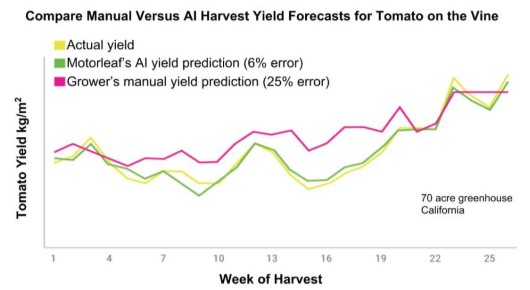
Greenhouse artificial intelligence can automate harvest forecasts with greater precision because an algorithm can conduct a continuous analysis of your growing conditions. Photo: Motorleaf
Greenhouse growing is one sector where growers are beginning to see real-world impacts from the adoption of artificial intelligence (AI) technology. The time is ripe to become more familiar with this novel tool.
Here are four ways AI can make plant production more efficient and profitable.
Learning by Repetition
Sophisticated AI software mimics the most basic way humans learn — by repeating a task, with the aim of getting better at a defined goal. Becoming an ace at poker provides an apt example. We begin by learning rules that set limits on what we can or cannot do. The rules make us focus on what is most relevant to achieving the goal of winning by playing the strongest hand. At first you play a series of poor hands, but you begin to understand why you lost. After playing more rounds, your follies become less common, and you start to learn strategies that improve your chances of winning.
With AI software, we start by setting a basic algorithm that sets the rules of the game and a defined goal. Rules can be, for instance, defining the most relevant growing conditions in your greenhouse, and a goal can be predicting the future flowering time for a variety of ornamentals. With the framework set, we now need to train the software to understand how to follow the rules and then make assessments that will likely achieve the goal with a high degree of confidence. Training involves having the algorithm analyze the data you have on hand. Data can be any information available in a digital format, ranging from spreadsheets of your past heating bills, to records of how fast ventilation fans spin at given times of the day, to measurements of dissolved solids in your irrigation system. Soon enough, the algorithm will understand how diverse growing conditions determine the future flowing time for an ornamental plant. Now trained, the smart software can analyze new data from your greenhouse and predict future outcomes for your greenhouse with precision.
AI as Your Digital Assistant
Greenhouse tasks that require detailed comparisons or trial-and-error assessments are prime targets for an upgrade with an AI digital assistant. Diagnosing diseases and pests in your greenhouse is one example. If you don’t recognize a crop disease or pest, you’ll need to do your research to identify the problem and know which integrated pest management strategy will stop it.
The good news is we now have thousands of digital photos of all major crops plagued with common ailments. Using these images to train an algorithm, smart software can recognize many crop diseases and recommend treatment strategies. You can download a free app for your smartphone and then snap a picture of an ailing greenhouse plant to obtain a diagnosis and recommended treatment within seconds.
Knowing the growing conditions that cause skin cracking and blemishes in vegetables is another problem of particular interest. Growers often adjust humidity, temperature, and irrigation through a process of trial and error before they find the right mix to control the problem. Forget trial and error. AI can learn patterns in growing conditions that cause skin cracking and recommend what to adjust first to maximize your yield of picture-perfect produce.
AI Makes Growing Precise
Imagine calculating all the financial information for your greenhouse by hand. Not only would this manual task be a frustrating waste of time, you might feel unsure about the accuracy of your results. This is why you use spreadsheets and a calculator to do complex math. AI is like a calculator because it can do complex calculations and avoid errors that pop up from manual work.
Forecasting harvest yields is a case in point. Growers need to know if they will harvest enough produce to meet contractual agreements with their buyers. Predicting the weekly harvest yields of, say, tomatoes and peppers is a manual process that requires counting underripe fruits and making informed guesses as to how current growing conditions will affect the speed at which they ripen. Not only is this a time-consuming process, it’s often imprecise; errors in forecasts can be off by 30% from the actual yield that week.
AI can automate harvest forecasts with greater precision because an algorithm can conduct a continuous analysis of your growing conditions. The algorithm can learn how growing conditions will affect the speed by which vegetables ripen, enabling growers to know their future harvest yields, within a single digit percentage point, weeks in advance.
AI Stores Skills and Knowledge
Growers are feeling the pinch from labor shortages of both skilled and unskilled workers. AI can help ease the pain of losing a skilled employee. Once you train an algorithm to learn a task, that skill will remain embedded in that smart software. Recall the previous example of harvest forecasting. Armed with the AI-automated forecaster, your greenhouse can continue this essential task even if you lose your head grower. After you find a replacement, they no longer need to learn how to conduct harvest forecasts, freeing their time to focus on more creative tasks that extend beyond the capacities of AI.
The potential for AI to automate and streamline operations in industries ranging from finance to health care demonstrates its broad impact on the future of business. The greenhouse industry is no exception. Given the novelty of the technology, we are in the early stages of outlining how best to use AI and defining what rules should govern the provision of data. While its novelty does raise questions, it is counterproductive for growers to shy away from this impressive technology.
Source: Greenhouse Grower











